| List of UK flags |
|---|
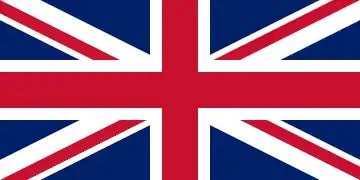 |
This is a list of English flags, including symbolic national and sub-national flags, standards and banners used exclusively in England. The College of Arms is the authority on the flying of flags in England and maintains the only official register of flags. It was established in 1484 and as part of the Royal Household operates under the authority of The Crown.[1] A separate private body called the Flag Institute, financed by its own membership, also maintains a registry of United Kingdom flags that it styles 'the UK Flag Registry', though this has no official status under English law.[2]
Certain classes of flag enjoy a special status within English planning law and can be flown without needing planning permission as advertisements. These include any country's national flag, civil ensign or civil air ensign; the flag of the Commonwealth, the United Nations or any other international organisation of which the United Kingdom is a member; a flag of any island, county, district, borough, burgh, parish, city, town or village within the United Kingdom; the flag of the Black Country, East Anglia, Wessex, any Part of Lincolnshire, any Riding of Yorkshire or any historic county within the United Kingdom; the flag of St David; the flag of St Patrick; the flag of any administrative area within any country outside the United Kingdom; any flag of His Majesty's Armed Forces; the Armed Forces Day flag;[3] and the flags of the National Health Service. The flag of the European Union previously held this special status but this was revoked and instead granted to the flags of the NHS on 24 March 2021, owing to heightened advocacy for the latter institution brought about by the COVID-19 Pandemic and following the United Kingdom's departure from the European Union on 31 January 2020.[4]
National flag
| Flag | Date | Use | Description |
|---|---|---|---|
 | 1417–Present | Flag of England (also known as the St George's Cross) | A centred red cross on a white background, 3:5.[5] |
.svg.png.webp) | A vertical centred red cross on a white background. |
Royal banner
| Flag | Date | Use | Description |
|---|---|---|---|
 | 1042–1066 | Former Royal Banner of England
(Attributed) |
A golden cross with fleur-de-lis ends over a blue field, surrounded by five golden martlets. This former Royal Banner was used by St Edward the Confessor, one of the last Anglo-Saxon English kings. |
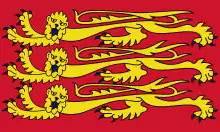 | circa 1200 | Present Royal Banner of England | Three gold lions (or leopards) passant on a red field. The Royal Banner of England is based on the Royal arms of England. The banner is neither a national flag or a royal standard, and only represents the ruling monarch exclusively in England. The Banner of England is included within the current Royal Standard, along with heraldic devices from the other constituent parts of the United Kingdom. |
Royal standards
| Flag | Date | Use | Description |
|---|---|---|---|
 | 1837 | Royal Standard of the United Kingdom. It is the banner of the king of the United Kingdom (King Charles III) in his capacity as king of the United Kingdom. | Split into quarters, the first and fourth quarters contain three gold lions passant on a red field (representing England and Wales); the second quarter contains a red lion rampant on a gold field (representing Scotland); the third quarter contains a gold harp on a blue field (representing Ireland). |
 | Standard of the Duchy of Lancaster | The Royal Banner of England, with a three-point label, each containing three fleurs-de-lis | |
.svg.png.webp) | 1305 | Standard of the Lord Warden of the Cinque Ports | A banner of the Lord's coat of arms, featuring three lions passant guardant conjoined to three hulls, all in gold |
Government
| Flag | Date | Use | Description |
|---|---|---|---|
 | 1829 | Flag of the Greater London Metropolitan Police | The Badge of the Metropolitan Police on a blue background, with white squares at the edge |
Church
| Flag | Date | Use | Description |
|---|---|---|---|
 | 1417–Present | Flag of England (also known as the St George's Cross) | A centred red cross on a white background, 3:5.[5] Churches belonging to the Church of England which have a pole may fly St George's Cross. A desirable variant is for the church to fly the flag with the arms of the diocese in the canton (left-hand upper corner). |
 | 1954 | Flag of the Anglican Communion | A dark blue background with the symbol of the Anglican Communion (a compass rose surmounted by a bishop's mitre; in the centre is a cross of St George). The Greek motto, Ἡ ἀλήθεια ἐλευθερώσει ὑμᾶς ("The truth will set you free") is a quotation from John 8:32. |
 | Flag of Westminster Abbey | Tudor arms between Tudor roses, above arms attributed to Edward the Confessor | |
 | Flag of the Church of St Margaret, Westminster Abbey | A blue flag defaced in the centre with a gold dragon's head pierced by a cross, and a gold crowned portcullis in the canton. | |
 | 2014 | Flag of Exeter Cathedral | The coat of arms of Exeter Cathedral on a field of blue. |
 | Flag of Southwark Cathedral | A banner of the Cathedral's coat of arms. | |
 | Flag of Worcester Cathedral | The Cross of Saint George defaced with the coat of arms of Worcester Cathedral in the canton. | |
 | 2013 | Flag of the Church of St James the Great, Birlingham | The Cross of Saint George impaled with a blue field defaced with three gold scallop shells of Saint James (two on the left and one on the right). |
 | Flag of St James Church, Quedgeley[6] | Three gold scallop shells of Saint James (two above and one below) on a field of red. | |
 | Flag of Saint Aldhelm | A white cross on a red field. | |
 | 2021 | Flag of Saint Augustine of Canterbury[7] | A white cross on a black field with a gold bishop's pallium topped by a small gold cross in the canton. |
 | Flag of Saint Peter, Westminster Abbey | Two crossed gold keys beneath a gold ring on a field of red. The symbols represent the two Patron Saints of the Abbey: the ring of Saint Edward the Confessor (founder of the Abbey), and the keys of Saint Peter. | |
 | Flag of Saint Richard of Chichester | A white cross on a red field with a white chalice in each quarter. |
Dioceses of the Church of England
| Flag | Date | Use | Description |
|---|---|---|---|
 | Flag of the Diocese of Bath and Wells | Cross of St. George with the heraldic shield of the Diocese of Bath and Wells in the canton. | |
 | Flag of the Diocese of Birmingham | Cross of St. George with the heraldic shield of the Diocese of Birmingham in the canton. | |
 | Flag of the Diocese of Blackburn | Cross of St. George with the heraldic shield of the Diocese of Blackburn in the canton. | |
 | Flag of the Diocese of Bristol | Cross of St. George with the heraldic shield of the Diocese of Bristol in the canton. | |
 | Flag of the Diocese of Canterbury | Cross of St. George with the heraldic shield of the Diocese of Canterbury in the canton. | |
 | Flag of the Diocese of Carlisle | Cross of St. George with the heraldic shield of the Diocese of Carlisle in the canton. | |
 | Flag of the Diocese of Chelmsford | Cross of St. George with the heraldic shield of the Diocese of Chelmsford in the canton. | |
 | Flag of the Diocese of Chester | Cross of St. George with the heraldic shield of the Diocese of Chester in the canton. | |
 | Flag of the Diocese of Coventry | A banner of the Diocese's coat of arms.[8] | |
 | Flag of the Diocese of Derby | Cross of St. George with the heraldic shield of the Diocese of Derby in the canton. | |
 | Flag of the Diocese of Durham | A banner of the Diocese's coat of arms. | |
 | Flag of the Diocese of Ely | Cross of St. George with the heraldic shield of the Diocese of Ely in the canton. | |
 | Flag of the Diocese of Exeter | Cross of St. George with the heraldic shield of the Diocese of Exeter in the canton. | |
 | Flag of the Diocese of Gibraltar in Europe | Cross of St. George with the heraldic shield of the Diocese of Gibraltar in Europe in the canton. | |
 | Flag of the Diocese of Gloucester | Cross of St. George with the heraldic shield of the Diocese of Gloucester in the canton. | |
 | Flag of the Diocese of Guildford | Cross of St. George with the heraldic shield of the Diocese of Guildford in the canton. | |
 | Flag of the Diocese of Hereford | Cross of St. George with the heraldic shield of the Diocese of Hereford in the canton. | |
 | Flag of the Diocese of Leeds | Cross of St. George with the heraldic shield of the Diocese of Leeds in the canton. | |
 | Flag of the Diocese of Leicester | Cross of St. George with the heraldic shield of the Diocese of Leicester in the canton. | |
 | Flag of the Diocese of Lichfield | Cross of St. George with the heraldic shield of the Diocese of Lichfield in the canton. | |
 | Flag of the Diocese of Lincoln | Cross of St. George with the heraldic shield of the Diocese of Lincoln in the canton. | |
 | Flag of the Diocese of London | Cross of St. George with the heraldic shield of the Diocese of London in the canton. | |
 | Flag of the Diocese of Manchester | Cross of St. George with the heraldic shield of the Diocese of Manchester in the canton. | |
 | Flag of the Diocese of Newcastle | Cross of St. George with the heraldic shield of the Diocese of Newcastle in the canton. | |
 | Flag of the Diocese of Norwich | Cross of St. George with the heraldic shield of the Diocese of Norwich in the canton. | |
 | Flag of the Diocese of Oxford | Cross of St. George with the heraldic shield of the Diocese of Oxford in the canton. | |
 | Flag of the Diocese of Portsmouth | Cross of St. George with the heraldic shield of the Diocese of Portsmouth in the canton. | |
 | Flag of the Diocese of Rochester | Cross of St. George with the heraldic shield of the Diocese of Rochester in the canton. | |
 | Flag of the Diocese of Salisbury | Cross of St. George with the heraldic shield of the Diocese of Salisbury in the canton. | |
 | Flag of the Diocese of Sheffield | Cross of St. George with the heraldic shield of the Diocese of Sheffield in the canton. | |
 | Flag of the Diocese of Southwark | Cross of St. George with the heraldic shield of the Diocese of Southwark in the canton. | |
 | Flag of the Diocese of Southwell and Nottingham | Cross of St. George with the heraldic shield of the Diocese of Southwell and Nottingham in the canton. | |
 | Flag of the Diocese of St Albans | Cross of St. George with the heraldic shield of the Diocese of St Albans in the canton. | |
 | Flag of the Diocese of Truro | Cross of St. George with the heraldic shield of the Diocese of Truro in the canton. | |
 | Flag of the Diocese of Winchester | Cross of St. George with the heraldic shield of the Diocese of Winchester in the canton. | |
 | Flag of the Diocese of Worcester | Cross of St. George with the heraldic shield of the Diocese of Worcester in the canton. | |
 | Flag of the Diocese of York | A banner of the Diocese's coat of arms. |
Regional flags
Flags of the former heptarchy of Anglo-Saxon kingdoms are registered as provincial flags:
| Flag | Date | Represents | Description |
|---|---|---|---|
 | 1900s | Kingdom of East Angliareg East Anglia and surrounding areas | The arms ascribed to the Wuffingas dynasty. Three crowns on a blue shield, superimposed on a St George's Cross, 3:5.[9] |
 | Ancient | Kingdom of Essexreg Historic county flag of Essex | The flag of Essex is ancient in origin and features three Saxon seax (cutlasses) on a red field.[10] |
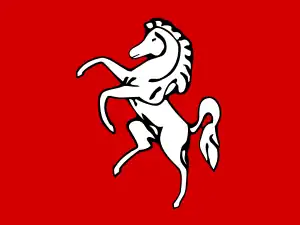 | 1605 | Kingdom of Kentreg Historic county of Kent | The flag of Kent has a red field with a white horse in the centre, 3:5.[11] |
.svg.png.webp) | 13th century | Kingdom of Mercia reg The Midlands | The Flag of Mercia, gold saltire on a blue field (Cross of St Alban), still flown on Tamworth Castle and a lighter version in St Albans. |
 | Ancient | Kingdom of Northumbriaregcoa North England | Eight alternating stripes of gold and burgundy[lower-alpha 1] |
 | Ancient | Kingdom of Sussexreg | Six gold martlets on a blue field. Officially adopted on 20 May 2011, 3:5. |
 | 1974.[12] | Kingdom of Wessexreg Areas of England once covered by the kingdom | A gold wyvern on a red field. Registered 20 May 2011. Designed in 1974 by William Crampton.[13] |
Historic counties
All 39 of the historic counties have flags registered with the Flag Institute, with Leicestershire being the last county to declare its flag, as of 16 July 2021. Some flags are traditional, meaning their designs have long been associated with the county (or in some cases, such as Kent and Sussex, an ancient kingdom), while other flags are based on the County Council arms or are winners of recent design competitions. The dates indicate the flag's date of first appearance, description, or in more recent examples, its registration with the Flag Institute.
| Flag | Date | Use | Description |
|---|---|---|---|
 | Traditional; 12 April 1951 | Flag of Bedfordshirereg coa | Traditional county flag. The red and yellow colours come from the Beauchamps family coat of arms. The vertical black stripe with three shells, or escallops, comes from the arms of the Dukes of Bedford. The wavy lines represent the River Great Ouse. A slightly updated version was registered with the Flag Institute on 14 September 2014 after Bedfordshire County Council was disbanded and replaced by two unitary authorities. |
 | Traditional; 2 March 2017 | Flag of Berkshirereg | Traditional badge: a stag beneath Herne the Hunter's oak. |
 | Traditional; 20 May 2011 | Flag of Buckinghamshirereg | Traditional county flag. A field party per pale of black and red with a white swan. |
 | 1 February 2015 | Flag of Cambridgeshirereg | The three gold crowns represent East Anglia, with wavy light blue lines representing the river Cam in the colours of Cambridge University on a dark blue background. |
|
|
3 May 1938 | Flag of Cheshire | Three golden sheaves of wheat and a golden blade on a blue background. The design has been associated with the Earldom of Chester since the 12th century, and has been used in the coat of arms of Chester since at least 1560. |
 | 19th century | Flag of Cornwall | St Pirran's Cross, a white cross on a black field. |
 | 19 September 1950 | Flag of Cumberland | Design based on the arms of the former Cumberland County Council.[14] |
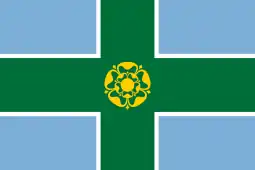 | 22 September 2006 | Flag of Derbyshirereg | A green cross with a white border on a sky blue field, with a gold Tudor rose in the centre, 3:5.[15] |
 | 23 July 2006 | Flag of Devon, alias St Petroc's Crossreg | A white cross with a black border on a green field, 3:5.[16] |
 | 16 September 2008 | Flag of Dorset – The Dorset Cross, aka St Wite's Crossreg | A white cross with a red border on a gold field, 3:5.[17] |
 | 21 November 2013 | Flag of County Durham | A gold and blue horizontal bicolour with St Cuthbert's Cross countercharged upon it, 3:5.[18] |
 | Ancient | Flag of Essexreg | A red field with three white, gold hilted seax (Saxon swords).[10] |
 | March 2008 | Flag of Gloucestershire – The Severn Crossreg | A mid-blue cross, outlined in cream, against an apple green background – the winning entry in a competition to commemorate the county's millennium.[19] |
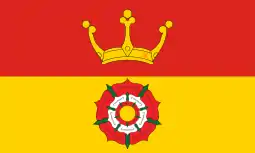 | 12 March 2019 | Flag of Hampshirereg | A gold Saxon crown above a Tudor rose over a field of red and gold representing the former Saxon kingdom of Wessex. |
 | 2 November 2019 | Flag of Herefordshirereg | On a dark red background, a white bull's head above three wavy lines, ordered white-blue-white.[20] |
 | 19 November 2008 | Flag of Hertfordshirereg coa | Against eight blue and white wavy lines, representing the county's rivers, a gold shield bearing a resting deer or hart.[21] |
 | 25 June 2009 | Flag of Huntingdonshirereg | On a green background, a gold, ribboned hunting horn – a flag displayed on the crest of the district council (and former county council) arms |
 | 1605 | Flag of Kentreg | A red field with a white horse in the centre, 3:5.[11] |
 | Modern form since 20 November 2008 | Flag of Lancashirereg | The Red Rose of Lancashire on a yellow field (originally a white field).[22][23] |
 | 16 July 2021 | Flag of Leicestershirereg | A red and white dancetté background, taken from the arms of Simon de Montfort, 6th Earl of Leicester; the Cinquefoil of the de Beaumont Earls of Leicester; and the running fox from the county's crest, used on many of the county organisations' emblems.[24] |
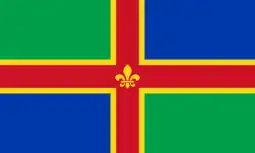 | 24 October 2005 | Flag of Lincolnshirereg | A red cross with yellow trimming on a blue and green field, and a yellow fleur de lys in the middle of the cross.[25] |
 | 1909 | Flag of Middlesexreg | A red field with three white, gold-hilted Saxon swords or seax under a gold Saxon crown.[26] |
 | 11 September 2014 | Flag of Norfolkreg | Ermine bend from top left to bottom right on a gold and black field.[27] |
 | 11 September 2014 | Flag of Northamptonshirereg | A gold cross with a black border on a maroon field with a rose in the centre.[28] |
 | 7th century (modern form 1951) | Flag of Northumberlandreg coa | Historical flag readopted in 1951 and used officially by the county council, and later released by the council and registered as the flag of the historic county. Eight yellow rectangles on a red field; note that the canton (top corner nearest the flagpole) should be gold.[29] |
 | 20 May 2011 | Flag of Nottinghamshirereg | The inescutcheon represents Robin Hood. |
 | 2017 on | Flag of Oxfordshire | The arms of the pre-1974 County Council: blue with a red ox head on a double bend wavy, between a wheatsheaf and an oak. (Registered by the Flag Institute)[30] |
 | 17 November 2015 | Flag of Rutlandreg coa | A green field semée of acorns with a golden horseshoe in the centre |
 | March 2012 | Flag of Shropshirereg | The leopards' faces, fondly referred to as "loggerheads" locally, are a traditional emblem for Shropshire and have historically evolved from the loggerheads on the Shrewsbury town arms. The erminois aspect differentiates the county flag from that of its county town. |
 | 4 July 2013 | Flag of Somersetreg | A red dragon rampant on a gold field, from a longstanding local badge; the winning entry in a competition. |
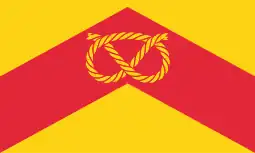 | 28 March 2016 | Flag of Staffordshirereg | A red chevron on a gold field, with a gold Stafford knot, the county's longstanding symbol. All elements are taken from the de Stafford coat of arms. Designed by the Staffordshire Heritage Group and chosen by the Flag Institute over the county council's own flag after a public vote.[31] |
 | 9 October 2017 | Flag of Suffolkreg | Derived from the arms attributed to Saint Edmund the Martyr.[32] |
 | 11 September 2014 | Flag of Surreyreg | Chequey Or and azure; a traditional design derived from a personal coat of arms first recorded in the 11th century.[33] |
 | 20 May 2011 | Flag of Sussexreg | Six gold martlets on blue are the traditional emblem of Sussex.[34] This flag is for public use by the entire shire county of Sussex and its people.[35] |
 | 15 August 2016 | Flag of Warwickshirereg | The traditional bear and ragged staff badge, shown white on red; the badge is from that of the Earls of Warwick. |
 | 30 September 2011 | Flag of Westmorlandreg | A golden heraldic apple tree on white and red bars. Westmorland is now part of the ceremonial county of Cumbria. |
 | 5 June 2007 | Flag of Wiltshirereg | Alternating stripes of green and white represent the grassy downs of the county and their chalk underlay. The colours can represent hope, joy and safety (green) and peace (white). In the centre, the male great bustard is depicted in gold on a solid green circle to represent the open grassland. The circle is bordered in six sections alternating green and white, representing the stone circles of Stonehenge and Avebury in the county. The six portions also represent the six surrounding counties of Gloucestershire, Oxfordshire, Berkshire, Hampshire, Dorset and Somerset. |
 | 8 April 2013 | Flag of Worcestershirereg | Black pears appear in the arms of the City of Worcester, and as such have long been considered a county badge, reportedly dating back to the Battle of Agincourt. The county flag was established by a competition in 2013.[36] |
 | 1965 or earlier | Flag of Yorkshirereg | The White Rose of York (the traditional county emblem) on a blue field.[37] |
Ceremonial counties
The counties and areas for the purposes of the lieutenancies, also referred to as the lieutenancy areas of England[38] and informally known as ceremonial counties,[39] are 48 areas of England to which lords-lieutenant are appointed. Legally, the areas in England, as well as in Wales and Scotland, are defined by the Lieutenancies Act 1997 as "counties and areas for the purposes of the lieutenancies in Great Britain", in contrast to the areas used for local government. They are also informally known as "geographic counties",[40] to distinguish them from other types of counties of England.
| Flag | Date | Use | Description |
|---|---|---|---|
 | Traditional; 12 April 1951 | Flag of Bedfordshirereg coa | The red and yellow colours come from the Beauchamps family coat of arms. The vertical black stripe with three shells, or escallops, comes from the arms of the Dukes of Bedford. The wavy lines represent the River Great Ouse. A slightly updated version was registered with the Flag Institute on 14 September 2014 after Bedfordshire County Council was disbanded and replaced by two unitary authorities. |
 | Traditional; 2 March 2017 | Flag of Berkshirereg | Traditional badge: a stag beneath Herne the Hunter's oak. |
 | Date registered | Flag of Bristol | No registered official ceremonial county flag. |
 | Traditional; 20 May 2011 | Flag of Buckinghamshirereg | A field party per pale of black and red with a white swan. |
 | 1 February 2015 | Flag of Cambridgeshirereg | Banner of the arms of Cambridgeshire County Council is used: wavy and straight blue lines representing the rivers and drains, and a tressure from the arms of the former Cambridgeshire and the Isle of Ely County Council. |
 | 3 May 1938 | Flag of Cheshire | Three golden sheaves of wheat and a golden blade on a blue background. The design has been associated with the Earldom of Chester since the 12th century, and has been used in the coat of arms of Chester since at least 1560. |
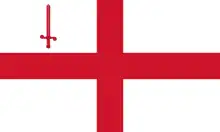 | 1381 | Flag of the City of London (Ceremonial county and city flag) | A red cross on a white field, with a red sword in the canton. The City of London (excluding Greater London) is England's smallest ceremonial county and measures approximately 1 square mile (2.6 km2). The City of London is officially not part of Greater London or its 32 borough's. |
 | Traditional | Flag of Cornwall – St Pirran's Cross | A white cross on a black field. |
 | Date registered | Flag of Cumbria | No registered official ceremonial county flag. |
 | 22 September 2006 | Flag of Derbyshirereg | A green cross with a white border on a sky blue field, with a gold Tudor rose in the centre, 3:5.[15] |
 | 23 July 2006 | Flag of Devon, alias St Petroc's Crossreg | A white cross with a black border on a green field, 3:5.[16] |
 | 16 September 2008 | Flag of Dorset – The Dorset Cross, aka St Wite's Crossreg | A white cross with a red border on a gold field, 3:5.[17] |
 | 21 November 2013 | Flag of Durham | A gold and blue horizontal bicolour with St Cuthbert's Cross countercharged upon it, 3:5.[18] |
 | 18 April 2013 | Flag of East Riding of Yorkshire (Ceremonial county) | A Yorkshire white rose, displayed in the East Riding style with one sepal at the top, set against a bi-colour of blue at the hoist, representing the sea and the historic maritime activities of the East Riding and green in the fly symbolising the locality's rich agricultural land. Additionally, the blue hoist colour signifies the East Riding's connection to the whole of Yorkshire whilst the green is placed towards the fly to represent its position in the east of the county. |
 | Date registered | Flag of East Sussex | No registered official ceremonial county flag, although it shares a historic county flag with West Sussex. |
 | Ancient | Flag of Essexreg | A red field with three white, gold hilted seax (Saxon swords).[10] |
 | March 2008 | Flag of Gloucestershire – The Severn Crossreg | A mid-blue cross, outlined in cream, against an apple green background – the winning entry in a competition to commemorate the county's millennium.[19] |
 | Date registered | Flag of Greater London | No registered official ceremonial county flag. |
 | Date registered | Flag of Greater Manchester | Unnofficial ceremonial county flag. |
 | 12 March 2019 | Flag of Hampshirereg | A gold Saxon crown above a Tudor rose over a field of red and gold representing the former Saxon kingdom of Wessex. |
 | 2 November 2019 | Flag of Herefordshirereg | On a dark red background, a white bull's head above three wavy lines, ordered white-blue-white.[20] |
 | 19 November 2008 | Flag of Hertfordshirereg coa | Against eight blue and white wavy lines, representing the county's rivers, a gold shield bearing a resting deer or hart.[21] |
 | January 2009 | Flag of the Isle of Wight (Ceremonial county and Island) reg | A white lozenge with an upper indent or "pile" on a light blue background, over six wavy stripes of blue and white. The Isle of Wight became administered by its own county council in 1890, but was formally part of Hampshire up until the local government reforms of 1974 when it became a full ceremonial county with its own Lord Lieutenant.[41] |
 | 1605 | Flag of Kentreg | A red field with a white horse in the centre, 3:5.[11] |
 | Modern form since 20 November 2008 | Flag of Lancashirereg | The Red Rose of Lancashire on a yellow field (originally a white field).[22][23] |
 | 16 July 2021 | Flag of Leicestershirereg | A red and white dancetté background, taken from the arms of Simon de Montfort, 6th Earl of Leicester; the Cinquefoil of the de Beaumont Earls of Leicester; and the running fox from the county's crest, used on many of the county organisations' emblems.[24] |
 | 24 October 2005 | Flag of Lincolnshirereg | A red cross with yellow trimming on a blue and green field, and a yellow fleur de lys in the middle of the cross.[25] |
 | Date registered | Flag of Merseyside | No registered official ceremonial county flag. |
 | 11 September 2014 | Flag of Norfolkreg | Ermine bend from top left to bottom right on a gold and black field.[27] |
 | Date registered | Flag of North Yorkshire | No registered official ceremonial county flag. |
 | 11 September 2014 | Flag of Northamptonshirereg | A gold cross with a black border on a maroon field with a rose in the centre.[28] |
 | 7th century (modern form 1951) | Flag of Northumberlandreg coa | Historical flag readopted in 1951 and used officially by the county council, and later released by the council and registered as the flag of the historic county. Eight yellow rectangles on a red field; note that the canton (top corner nearest the flagpole) should be gold.[29] |
 | 20 May 2011 | Flag of Nottinghamshirereg | The inescutcheon represents Robin Hood. |
 | 2017 on | Flag of Oxfordshire | The arms of the pre-1974 County Council: blue with a red ox head on a double bend wavy, between a wheatsheaf and an oak. (Registered by the Flag Institute)[42] |
 | 17 November 2015 | Flag of Rutlandreg coa | A green field semée of acorns with a golden horseshoe in the centre |
 | March 2012 | Flag of Shropshirereg | The leopards' faces, fondly referred to as "loggerheads" locally, are a traditional emblem for Shropshire and have historically evolved from the loggerheads on the Shrewsbury town arms. The erminois aspect differentiates the county flag from that of its county town. |
 | 4 July 2013 | Flag of Somersetreg | A red dragon rampant on a gold field, from a longstanding local badge; the winning entry in a competition. |
 | Date registered | Flag of South Yorkshire | No registered official ceremonial county flag. |
 | 28 March 2016 | Flag of Staffordshirereg | A red chevron on a gold field, with a gold Stafford knot, the county's longstanding symbol. All elements are taken from the de Stafford coat of arms. Designed by the Staffordshire Heritage Group and chosen by the Flag Institute over the county council's own flag after a public vote.[31] |
 | 9 October 2017 | Flag of Suffolkreg | Derived from the arms attributed to Saint Edmund the Martyr.[32] |
 | 11 September 2014 | Flag of Surreyreg | Chequey Or and azure; a traditional design derived from a personal coat of arms first recorded in the 11th century.[33] |
 | Date registered | Flag of Tyne and Wear | No registered official ceremonial county flag. |
 | 15 August 2016 | Flag of Warwickshirereg | The traditional bear and ragged staff badge, shown white on red; the badge is from that of the Earls of Warwick. |
 | Date registered | Flag of West Midlands | No registered official ceremonial county flag. |
 | Date registered | Flag of West Sussex | No registered official ceremonial county flag, although it shares a historic county flag with East Sussex. |
 | Date registered | Flag of West Yorkshire | No registered official ceremonial county flag. |
 | 5 June 2007 | Flag of Wiltshirereg | Alternating stripes of green and white represent the grassy downs of the county and their chalk underlay. The colours can represent hope, joy and safety (green) and peace (white). In the centre, the male great bustard is depicted in gold on a solid green circle to represent the open grassland. The circle is bordered in six sections alternating green and white, representing the stone circles of Stonehenge and Avebury in the county. The six portions also represent the six surrounding counties of Gloucestershire, Oxfordshire, Berkshire, Hampshire, Dorset and Somerset. |
 | 8 April 2013 | Flag of Worcestershirereg | Black pears appear in the arms of the City of Worcester, and as such have long been considered a county badge, reportedly dating back to the Battle of Agincourt. The county flag was established by a competition in 2013.[36] |
Islands
| Flag | Date | Use | Description |
|---|---|---|---|
 | 14 April 2010 | Flag of the Isle of Portlandreg | The colours represent the landscape of the area: Portland stone, grass and the sea. The white tower represents the castles and the naval coronet shows the long connection with the Royal Navy.[43] |
 | 2019 | Flag of the Isle of Purbeckreg An island in name only; not geographically an island. | Symbols include a curving wave, an ammonite and fish. The island's flag day is 26 November.[44] |
 | January 2009 | Flag of the Isle of Wight reg | A white lozenge with an upper indent or "pile" on a light blue background, over six wavy stripes of blue and white. The Isle of Wight became administered by its own county council in 1890, but was formally part of Hampshire up until the local government reforms of 1974 when it became a full ceremonial county with its own Lord Lieutenant.[41] |
Local government areas
Heraldic bearings are granted to individuals and corporations by the Lord Lyon in Scotland or by the College of Arms in England, Northern Ireland and Wales on behalf of the sovereign as the fount of all honours. Local authority flags come within this category when based on the arms granted to that authority, and such a flag is the authority's personal property, representing that authority rather than its area.
| Flag | Date | Use | Description |
|---|---|---|---|
 | Former Bedfordshire Council banner | Red and gold quarters split horizontally by blue and white waves and vertically with a black band containing three white shells.
The red and gold quarters are from the arms of the Beauchamps, the leading family in the county after the Norman Conquest. The waves signify the River Great Ouse, and the shells are from the arms of the Russell Family, commemorating their services to the state and to the county. | |
.png.webp) | Berkshire's banner of arms | Two lions passant (referencing Berkshire's Royal and Norman connections) and a Saxon Crown (referencing Berkshire's formative Saxon history) on a white background. | |
 | Flag of Cambridgeshire Council | Local authority flag. Gold with a red bordure based on the Scottish tressure. The blue wavy pallets represent the many rivers of the county, while the straight pallets are for the drains and dykes that run through the Fenlands. | |
 | Flag of the former Cheshire Council | Local authority flag. A trio of golden wheatsheaves on blue which have been associated with the Earldom of Chester since the late 12th century. | |
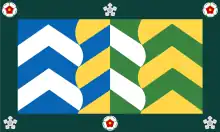 | Flag of Cumbria Council | On the green border are Parnassus flowers (representing Cumberland) interspersed with white roses (Yorkshire) superimposed with red roses (Lancashire). The centre of the shield is made up of segments of blue, white, yellow and green divided by wavy vertical lines and zig-zag horizontal lines. This depicts the new County and from left to right the vertical lines of segments show: blue and white for the sea, blue and yellow (gold) for the lakes and agriculture, green and white for mountains and lakes and green and yellow (gold) for mountains and agriculture. | |
.png.webp) | Flag of Dorset Council | Three red lions passant (referencing Dorset's Royal and Norman connections) and a fleur-de-lys on a white background. Banner of the Dorset Council Arms. | |
 | Flag of Durham County Council | Local authority flag. A yellow cross on a blue field with lions rampant in each quarter, the centre of the cross is broken with a white rose of York (to represent the area of Yorkshire in Teesdale administered by the council) and black diamonds on each arm. Flag modified from the arms of the Bishopric of Durham[45] | |
 | Flag of East Riding of Yorkshire Council | Local authority flag based on the coat of arms. | |
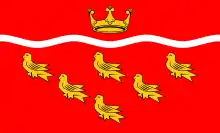 | 1975 | Flag of East Sussex Council | The banner of arms was granted to East Sussex County Council by the College of Arms in 1975.[46] |
 | 1965-1986 | Former Flag of Greater London Council | The former flag of the Greater London Council (1965-1986), a local government body which merged Middlesex with parts of Surrey, Kent, Essex and Hertfordshire to form Greater London. The GLC replaced the earlier London County Council (1889-1965). |
.png.webp) | 2020 | Flag of Greater London Authority | The corporate flag of the Greater London Authority. It is not the ceremonial county flag for Greater London, as no such current design exists. Other administrative flags were previously used officially between 1965 and 1984 by the Greater London Council and the County of London between 1889 and 1965. Both were based on the coats of arms of those councils.[47] |
 | Former Greater Manchester Council flag | Local authority flag. "Gules, ten Towers three two three two, all within a Bordure embattled Or". | |
 | Flag of Hampshire Council | Hampshire County Council local authority flag. This is a corporate flag, not the ceremonial county flag of Hampshire. | |
 | Flag of Herefordshire Council | Local authority flag. The red field represents the county's red earth. Across this runs a white and blue wave for the River Wye. In chief is a gold lion from the arms of the City of Hereford, and in base is a Herefordshire Bull's head. | |
 | November 2008 | Flag of Hertfordshirecoa | Against eight blue and white wavy lines, representing the county's rivers, a gold shield bearing a resting deer or hart. (Also used as a county flag.)[21] |
 | 1938 | Flag of Isle of Wight Council | County council flag. Features a representation of Carisbrooke Castle against a surrounding blue field and three gold anchors represent the island's status and maritime history. |
 | Flag of Lancashire County Council | A banner of the council's coat of arms. | |
 | Flag of Leicestershire Council | The flag is divided into four quarters. The first quarter is a cinquefol, or five within a red circle, the second quarter is charged a white lion with two tails on a red ground, the third quarter shows an ermine plume on a red ground and the fourth shows a black maunch.[48] | |
 | 1 April 1974 to 31 March 1986 | Former Merseyside Council flag | The waves represent the River Mersey; the six golden mural crowns represent the six County Boroughs—Birkenhead, Bootle, Liverpool, Southport, St Helens, and Wallasey—that Merseyside was created from.. |
 | Flag of Norfolk Council | The top part of the flag shows a lion from the Royal arms of England together with ostrich plumes and coronet referring to the Prince of Wales. This is a very special honour for the County Council, the King, in the Royal Licence, specifically instructs on the design of the arms to be granted "in commemoration of our long residence in Norfolk". This of course refers to Sandringham. The lower part of the flag comprises the arms attributed to Ralph de Gael or Guader, first Earl of Norfolk circa 1069. The ermine may well refer to Brittany as Ralph was Lord of Gael in that Duchy. | |
 | 7th century (modern form 1951) | Flag of Northumberland | Historical flag readopted in 1951 and used officially by the county council, and later released by the council and registered as the flag of the historic county. Eight yellow rectangles on a red field, note that the canton (top corner nearest the flagpole) should be gold.[29] |
 | Flag of Nottinghamshire Council | Local authority flag. The wave is for River Trent and the oak tree for Sherwood Forest. | |
 | Flag of Rutland Council | Local authority flag. A green background strewn with golden acorns, surrounding a central golden horseshoe. | |
 | Flag of Somerset Council | Local authority flag. A red dragon on a yellow field, bearing a blue mace – a banner of the county arms.[49] | |
 | Former South Yorkshire Council | Flag based on the council's arms. | |
 | Flag of Staffordshire Council | Local authority flag. All the devices on the flag come from arms of various Earls of Stafford. The red chevron on gold was the arms of the de Staffords. It is charged with the family's famous Stafford knot badge. The lion represents the authority of the council. | |
 | Flag of Suffolk Council | Local authority flag. Coat of arms of Suffolk on a gold background. The main charge in the arms is the sun rising over the sea. Suffolk is the most easterly county in England and thus the first to see the sun rise. The open crowns and crossed arrows refer to Bury St Edmunds and have been widely used in the arms of Suffolk towns and districts. | |
 | Flag of Surrey Council | Local authority flag. Divided into halves, blue and black, with two gold keys representing the Chertsey Abbey, a woolpack on blue and a sprig of oak on black. (a banner of the modern coat of arms of Surrey County Council). | |
 | Former Tyne and Wear Council flag | Former local authority flag. | |
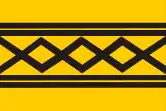 | Former West Midlands Council flag | Local authority flag. The flag has two dancetty barrulets interlaced to form a W and M representing the initials of "West Midlands". | |
 | 1889-1974 | Former West Sussex Council flag | Blue and gold flag with six golden martlets. Old 1889-1974 West Sussex County Council flag.[46] |
.png.webp) | 2008–Present | West Sussex Council flag | A blue banner with 7 light blue wavy lines with the crowned coat of arms in the centre in white.[46] |
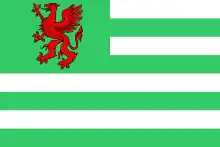 | Flag of Wiltshire Council | A banner of the council's coat of arms. |
Cities
This a list of officially recognised flags for various cities in England. Where listed as 'official', they have been registered by the Flag Institute charity or another official source. This list may be incomplete, please add official flags with sources showing the official flag design.
| Flag | Date | Use | Ceremonial County | Description | |
|---|---|---|---|---|---|
 |
Official community design[50] | 2015 | Flag of Birmingham (City and Metropolitan borough) | West Midlands | Golden vertical zig-zag offset to hoist dividing blue and red, with a bulls head in the centre. Updated in 2015 from the 1977 banner of arms. |
 |
Official design | 2018[51] | Flag of Coventry (City and metropolitan borough). | West Midlands | Silhouette of Lady Godiva on a white field with two stripes in the traditional shade of Coventry Blue. Updated in 2018 from the 1345 arms flag depicting an Elephant.[52] |
 |
1615 (Arms) | Flag of Durham (City and civil parish) | County Durham | A red cross outlined in white on a black field. | |
 |
1620 (Arms) | Flag of Plymouth (City and unitary authority) | Devon | Arms of Plymouth City Council set on a red field. | |
 |
1194, 1622, 1686 (Arms) | Flag (or Banner of arms) of Portsmouth (City and unitary authority) | Hampshire | A crescent of gold on a shade of azure, with a blazing star of eight points. Portsmouth's original 1194 arms are based on those used by King Richard I and William de Longchamp, who granted Portsmouth its town charter in 1194. Portsmouth's arms predate the College of Arms, but were confirmed by Heraldic visitations in 1622 (by John Philipot) and in 1686 (by Henry St George, the younger).[53] The Portsmouth arms are officially owned by Portsmouth City Council.[54] | |
 |
2012[55] | Flag of Preston (City and non-metropolitan district) | Lancashire | A Paschal Lamb couchant Argent supporting a Cross-Staff Or taken from the coat of arms of c.1613[56] on a white cross, enlaid with a blue cross, on a blue field. | |
 |
Recognised design | 2017[57] | Flag of Southampton (City and unitary authority) | Hampshire | An anchor and Tudor Rose on a red and white field. Updated in 2017 from the arms flag of 1575.[58] |
Towns
| Flag | Date | Use | Description |
|---|---|---|---|
 | 2014 | Flag of Appleby-in-Westmorlandreg (Town and civil parish, Cumbria) | A gold apple tree on a blue field. |
 | 2020 | Flag of Bexhill-on-Seareg (Town and civil parish, East Sussex) | A red saltire on a counter-changed field of green and white. |
 | 2017 | Flag of Bloxwichreg (Town and civil parish, West Midlands) | A counter-changed black and green cross on a white field with a rampant black lion in the canton and a green tree in the hoist. |
 | 2009 | Flag of Calnereg (Town and civil parish, Wiltshire) | |
 | 2016 | Flag of Caterhamreg (Town, Surrey) | |
 | 2016 | Flag of Heathfieldreg (Town, East Sussex) | A flag divided from top-left to bottom-right by a white line, with a white cuckoo on black in the hoist, and a white tower (defaced with a green key) on green in the fly. |
 | 2011 | Flag of Kingswinfordreg (Town, West Midlands) | |
 | 2013 | Flag of Newburyreg (Town, Berkshire) | |
 | 2012 | Flag of Penrithreg (Town and civil parish, Cumbria) | A red saltire on white with blue knot/flowers in each quarter. |
 | 2008 | Flag of Petersfieldreg (Town and civil parish, Hampshire) | |
 | 2020 | Flag of Poolereg (Town, Dorset) | |
 | 2012 | Flag of St Annes-on-the-Seareg (Town, Lancashire) | |
 | 2019 | Flag of Wadhurstreg (Town and civil parish, East Sussex) | A golden-orange "W" shape on a green field, with three white six-pointed estoiles between the arms of the "W". |
 | 2014 | Flag of Willenhallreg (Town and civil parish, West Midlands) |
Villages
| Flag | Date | Use | Description |
|---|---|---|---|
 | 2016 | Flag of Cromfordreg (Village and civil parish, Derbyshire) | |
 | 2014 | Flag of Evenleyreg (Village and civil parish, Northamptonshire) | |
 | 2012 | Flag of Florereg (Village and civil parish, Northamptonshire) | |
 | 2016 | Flag of Four Elmsreg (Village, Kent) | |
 | 2014 | Flag of Hampton Poylereg (Village, Oxfordshire) | |
 | 2014 | Flag of Horningseareg (Village, Cambridgeshire) | |
 | 2019 | Flag of Mardenreg (Village and civil parish, Herefordshire) | |
 | 2014 | Flag of Nentheadreg (Village, Cumbria) | |
 | 2014 | Flag of Pewseyreg (Village and civil parish, Wiltshire) | |
 | 2013 | Flag of Stainingreg (Village and civil parish, Lancashire) | |
 | 2013 | Flag of Wingreg (Village and civil parish, Buckinghamshire) | |
 | 2015 | Flag of Wreayreg (Village, Cumbria) | |
 | 2009 | Flag of Wroxtonreg (Village and civil parish, Oxfordshire) |
University flags
| Flag | Date | Use | Description |
|---|---|---|---|
 | Flag of the University of Bristol | ||
 | Flag of the University of Cambridge[59] | ||
 | Flag of the University of East Anglia | ||
 | Flag of the University of Hull | The Cross of Saint George defaced in the centre with the university's coat of arms. | |
 | Flag of the University of London | ||
 | Flag of the University of Oxford | An open book with the inscription Dominus Illuminatio Mea (Latin for "The Lord is my light"), surrounded by three golden crowns (two above and one below) on a blue field. | |
 | Flag of the University of Roehampton[60] | ||
 | Flag of the University of Warwick |
Other flags
| Flag | Date | Use | Description |
|---|---|---|---|
 | 1998 | Flag of the Campaign for an English Parliament | |
 | 1984 | Flag of English Heritage |
Historical flags
Royal standards
| Flag | Date | Use | Description |
|---|---|---|---|
 | 1066 | Banner of King Harold II | The reconstruction of the "Fighting Man Banner" mentioned by William of Poitiers. Was the military standard or personal banner of Harold Godwinson who led the Anglo-Saxon army in the Battle of Hastings (1066) against the Norman invaders. |
 | 1198–1340 | Royal Banner of King Richard I | Gules three lions passant guardant in pale Or armed and langued Azure,[61][62] meaning three gold lions with blue tongues and claws, walking and facing the observer, arranged in a column on a red background. It forms the first and fourth quarters of the Royal Standard of the United Kingdom. |
.svg.png.webp) | 1340–1395 1399–1406 | Royal Banner of King Edward III | The Coat of Arms of England quartered with the Royal Standard of France, the fleurs-de-lis representing the English claim to the French throne. |
.svg.png.webp) | 1395–1399 | Royal Banner of King Richard II | The Coat of Arms of England impaled with attributed arms of King Edward The Confessor (symbolising mystical union). |
.svg.png.webp) | 1406–1422 1461–1470 1471–1554 1558–1603 | Royal Banner of King Henry IV | The French quartering has been altered to three fleurs-de-lis. |
.svg.png.webp) | 1422–1461 1470–1471 | Royal Banner of King Henry VI | The Coat of Arms of France impaled with the Coat of Arms of England. |
.svg.png.webp) | 1554–1558 | Royal Banner of Queen Mary I | The Coat of Arms of Habsburg Spain impaled with the Coat of Arms of England. |
.svg.png.webp) | 1603–1689, 1702–1707 | Royal Standard of the House of Stuart, used first by James VI and I | A banner of the Royal Coat of Arms of James I, first and fourth quarters representing England and the English claim to the French throne, second quarter representing Scotland, third quarter representing Ireland. This was the last royal banner of the Kingdom of England. |
.svg.png.webp) | 1689–1694 | Royal Standard of King William III and II and Queen Mary II | A banner of the joint Royal Coat of Arms of William III and Mary II, consisting of the Coat of Arms of England defaced with an inescutcheon for the House of Nassau (representing William) and impaled with another undefaced version of the same Coat of Arms (representing Mary). |
.svg.png.webp) | 1694–1702 | Royal Standard of King William III and II | A banner of the Royal Coat of Arms of William III, first and fourth quarters representing England and the English claim to the French throne, second quarter representing Scotland, third quarter representing Ireland, with an inescutcheon for the House of Nassau. |
National flags and ensigns
| Flag | Date | Use | Description |
|---|---|---|---|
  | Anglo-Saxon era | Reputedly to symbolise Anglo-Saxon England[63] | In Historia Brittonum, two dragons appear. The red dragon symbolised the Welsh while a white dragon symbolised the Anglo-Saxons. A dragon (known later in heraldry as a wyvern) also later appears twice in the death scene of King Harold II on the Bayeux Tapestry depicting the Battle of Hastings in 1066.[63]
The Modern White Dragon Flag of England is based on a legend in Geoffrey of Monmouth's "History of the Kings of Britain".[64] In modern times, it is often used by a minority of English nationalist organisations.[65] |
 | 1620–1707 | English Red Ensign | Ensign of the red squadron with the Flag of England in the canton |
 | 1620–1702 | English White Ensign | Ensign of the white squadron with the Flag of England in the canton |
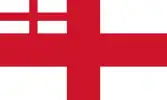 | 1702–1707 | English White Ensign | Ensign of the white squadron with the Flag of England in the canton with large cross of St George placed upon a white background |
 | 1620–1707 | English Blue Ensign | Ensign of the blue squadron with the Flag of England in the canton |
.svg.png.webp) | 1606–1801 | First Union Jack/Flag of the United Kingdom of Great Britain | The first Union Flag (also known as the King's Colours) with the Cross of St George placed upon the Flag of Scotland |
County flags
| Flag | Date | Use | Description |
|---|---|---|---|
.svg.png.webp) | pre–2008 | Unofficial flag of Lancashire | The Red Rose of Lancashire on a white field. It was denied registration by the Flag Institute, due to being almost identical to the already registered flag of the town of Montrose, Angus. |
See also
Footnotes
- ^reg Registered by the Flag Institute, a UK vexillology organisation that documents, guides and promotes the design, research and use of flags, but does not hold official status or authority.
- ^coa Designed by the College of Arms, the only legal body to grant official arms.
Notes
- ↑ Historic: gold and purple
Alternative: gold and red
Registered: gold and burgundy
References
- ↑ "About Us". The College of Arms. Retrieved 22 December 2012.
The College is also the authority for matters relating to the flying of flags, and holds the only official registers of flags for the UK and much of the Commonwealth.
- ↑ "UK Flag Registry". The Flag Institute. Retrieved 22 December 2012.
- ↑ "Plain English guide to flying flags" (PDF). Department for Communities and Local Government. November 2012. Archived from the original (PDF) on 21 October 2013. Retrieved 22 December 2012.
- ↑ "Union flag to be flown on UK Government buildings every day". GOV.UK. Retrieved 28 June 2021.
- 1 2 Flag of England
- ↑ "The Saint James Flag". St James' Church, Quedgeley & Kingsway. Retrieved 18 May 2023.
- ↑ "Banner of St Augustine flies over his city". Church Times. 25 June 2021. Retrieved 23 April 2023.
- ↑ "Flying the flag for the diocese". Diocese of Coventry. 7 July 2021. Retrieved 18 November 2022.
- ↑ Flag of East Anglia, traditional.
- 1 2 3 Flag of Essex, traditional.
- 1 2 3 Flag of Kent, traditional.
- ↑ "Wessex Flag | UK Flag Registry".
- ↑ "Wessex Flag | UK Flag Registry".
- ↑ Flag of Cumberland, traditional.
- 1 2 Flag of Derbyshire, selected by public vote.
- 1 2 Flag of Devon, selected by public vote.
- 1 2 Flag of Dorset, selected by public vote.
- 1 2 "County Durham flag with St Cuthbert's cross wins vote". BBC News. 21 November 2013. Retrieved 5 June 2016.
- 1 2 Flag of Gloucestershire, selected by competition by the High Sheriff of Gloucester.
- 1 2 http://www.flaginstitute.org/wp/flags/Herefordshire/
- 1 2 3 Flag of Hertfordshire, selected by local council.
- 1 2 The Flag of Lancashire with a white field has been commonplace for many years. The change from a white to a yellow field was made at the request of the Flag Institute before registration, as the white field version is a banner of the arms of Montrose.
- 1 2 Flag of Lancashire, selected by County Organisation.
- 1 2 Flag of Leicestershire, selected by all seven Leicestershire MPs.
- 1 2 Flag of Lincolnshire, selected by public vote.
- ↑ Flag of Middlesex, based on former council's arms, from a traditional emblem.
- 1 2 Flag of Norfolk, this design is the banner of the arms attributed to Ralph de Gael, first Earl of Norfolk.
- 1 2 Flag of Northamptonshire, selected by public vote.
- 1 2 3 Flag of Northumberland, selected by local Council.
- ↑ "Oxfordshire". UK Flag Registry. The Flag Institute.
- 1 2 "Staffordshire County Flag Vote". The Flag Institute. 28 February 2016. Retrieved 5 June 2016.
- 1 2 "Suffolk". The Flag Institute. Retrieved 10 December 2017.
- 1 2 Strangeway, Andy (19 September 2014). "Surrey Flag". British County Flags. Retrieved 5 June 2016.
- ↑ "The Sussex County Flag | The history behind the Martlets". Sussexflag.wordpress.com. 20 May 2011. Retrieved 19 May 2022.
- ↑ "Sussex flag flies above Whitehall to mark Sussex Day".
- 1 2 "Worcestershire". The Flag Institute. Retrieved 5 June 2016.
- ↑ Flag of Yorkshire
- ↑ Text of the Lieutenancies Act 1997 – Schedule 1: Counties and areas for the purposes of the lieutenancies in Great Britain as in force today (including any amendments) within the United Kingdom, from legislation.gov.uk. Retrieved 2011-05-03.
- ↑ "Ceremonial and Historic county boundary data added to OS OpenData". ordnancesurvey.co.uk.
- ↑ "England - Geographic counties". Encyclopædia Britannica.
- 1 2 UK Government (1972). "Local Government Act 1972". Retrieved 28 November 2016.
- ↑ "Oxfordshire". UK Flag Registry. The Flag Institute.
- ↑ of Isle of Portland
- ↑ "Isle of Purbeck Flag | UK Flag Registry".
- ↑ "County Durham, England". Flags of the World. 2015. Retrieved 5 June 2016.
- 1 2 3 "Council Flags". 11 March 2015.
- ↑ "Greater London (England)".
- ↑ "County Flag of Leicestershire". Leicestershire County Council. 8 March 2012. Retrieved 14 November 2012.
- ↑ "Newsletter (No. 3)". College of Arms. November 2004. Retrieved 5 June 2016.
- ↑ Council, Birmingham City. "Birmingham community flag". birmingham.gov.uk. Retrieved 22 May 2022.
- ↑ "Coventry Flag | UK Flag Registry".
- ↑ "Coventry - Coat of arms (Crest) of Coventry". 28 December 2022.
- ↑ "Portsmouth's Coat of Arms".
- ↑ "Portsmouth's Coat of Arms".
- ↑ "Preston Flag | UK Flag Registry".
- ↑ "Preston - Coat of arms (Crest) of Preston". 28 December 2022.
- ↑ "Community Flag".
- ↑ "Southampton (England) - Coat of arms (Crest) of Southampton (England)". 28 December 2022.
- ↑ Rob Raeside (29 June 2007). "Cambridge University (England)". Flags of the World. Retrieved 9 November 2022.
- ↑ Ron Lahav and Laurence Jones (10 February 2006). "University of Roehampton (England)". Flags of the World. Retrieved 11 November 2022.
- ↑ Fox-Davies, Arthur Charles (2008) [1909]. A Complete Guide to Heraldry. READ. p. 607.
- ↑ "Coat of Arms of King George III". The First Foot Guards. Retrieved 4 February 2010.
- 1 2 "We Are The English The White Dragon". wearetheenglish.com. Retrieved 14 May 2022.
- ↑ Dee, Edmund (2005). White Wyrm Rising. Athelney. p. 82. ISBN 1903313066.
- ↑ White, Ethan Doyle (2021). "In Woden's Shadow: Anglo-Saxonism, Paganism, and Politics in Modern England". Studies in Medievalism (30): 144–145.